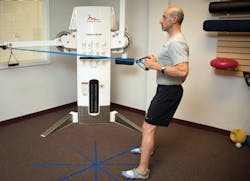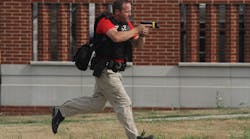In last month’s column on abdominal training we discussed some of the common myths, misconceptions and looked at some new and arguably better ways to train the abdominal wall. After reading and trying the exercises demonstrated you will have quickly felt the abdominal wall fire in a way that you have probably not felt before. You felt a global “firing” of the abdominal wall and the “core”. When the core fired it also served to “stiffen the spine”. One of the primary jobs of the abdominal wall is to provide stiffness for the torso and trunk and to help cinch down and protect the spine. We all intuitively know that strong abs = strong back.
As I travel the country teaching public safety professionals how to reduce injury, get fit and improve tactical performance we always cover the second most controversial topic which behind abdominal training is the lower back. Please understand that to have a strong lower back requires strong abdominals, hips, legs and torso. The spine is not meant to be strong, it’s job is to protect the spinal cord and act as attachment points for muscles, tendons and ligaments. The only true movement that the spine generates is roll-spin-yaw of the vertebral bodies and this is accomplished by some very small stabilization muscles that are essentially fine motor stabilizers. The rest of the movement in the spine is influenced by the muscles in the entire back, Lats, hips and glutes, abdominals and believe it or not the foot and ankle. As much as I would like to explain that last point it is not in the scope of this article.
Many an officer will, after spending countless hours in a patrol car, begin to experience pain, stiffness and general discomfort in the lower back. Standing for long periods, dangerous inefficient exercise and muscle tightness will also cause an officer to experience symptoms in the lower back. Unless you have a disk bulge, herniation or spine stenosis the pain you are experiencing is most likely a symptom of a problem from somewhere else. But as any diligent and responsible officer does you go to the gym and do rep after rep of back extensions, hyper extensions and god knows what else in the thought that it will strengthen your back. Sadly this is the farthest from the truth and it will only serve to make your back weaker and more inflamed.
To train the back and ultimately reduce your chance for injury we need to look at the parts of the body that when not doing their job put strain on the spine. Let’s break it down into three regions 1) hips/glutes 2) middle back muscles 3) Abs. The abs we talked about at length last month so those exercises are still in play.
The exercises that follow are specifically designed to get the muscles in the hips/glutes and the middle back to “do their job” and stop asking the lower back to take the load, which we said is not the spines job in the first place. So these exercises demonstrated here are designed to do a few things at the same time. 1) Fire the glutes/hips 2) contract the mid-back muscles 3) stiffen the spine 4) encourage proper foot-ankle & knee motion. These look weird and admittedly they are, but brothers/sisters, they are very effective.
The First exercise is a squat to fly: With a pair of light dumbbells take a hip width stance. As you squat to parallel (making sure the feet are rooted and still, knees are straight) reach the DB’s away from your body but do not lean forward. Keep your head up and back flat. Pause at parallel and on the controlled ascent imagine squeezing a gold coin between your cheeks just before you reach the top, do not let the coin drop. The knees remain slightly flexed, repeat for 3 sets of 15 repetitions.
The second exercise is a squat to a row: Just like to first exercise our goal is a stable foot/ankle and good knee alignment. Using a band or cable squat to parallel, pause (head up, back flat, knees straight) on the ascent row the weight back to the sides of your chest and at the same moment in time I want you to fire 1) your shoulder blades 2) glutes. This contraction or firing occurs at the top of the movement just before you pause. As before imaging squeezing a coin between your cheeks and an egg between your shoulder blades at the same moment in time. As I teach my officers rowing movement have no hugs and no shrugs so hands off the body and no shrugging.
While there are literally hundreds of other exercises these will help to activate the glutes, hips and middle back while creating some mobility and stability in the lower body.
A final note; to all the officers who could do nothing but comment negatively on the five finger exercise shoes I am wearing in the pictures, if you have a question on the shoes and are curious about their benefits and risks just ask. Besides they will challenge you in the gym in a whole new way, while not great for running they are great in the gym.
Web Links:
About The Author:
Bryan Fass is the author of “Fit Responder”, a comprehensive wellness plan for the first responder, and the Fit Responder Blog. Bryan has a Bachelor’s Degree in Sports Medicine and is certified as a licensed athletic trainer and a strength and conditioning specialist. He was a paramedic for over 8 years. Bryan has authored four books regarding fitness, wellness and human performance. Bryan is available for Consulting and Speaking on Public Safety Fitness Testing along with Fitness, Wellness and Injury Prevention Programs. Contact him via email to [email protected].



